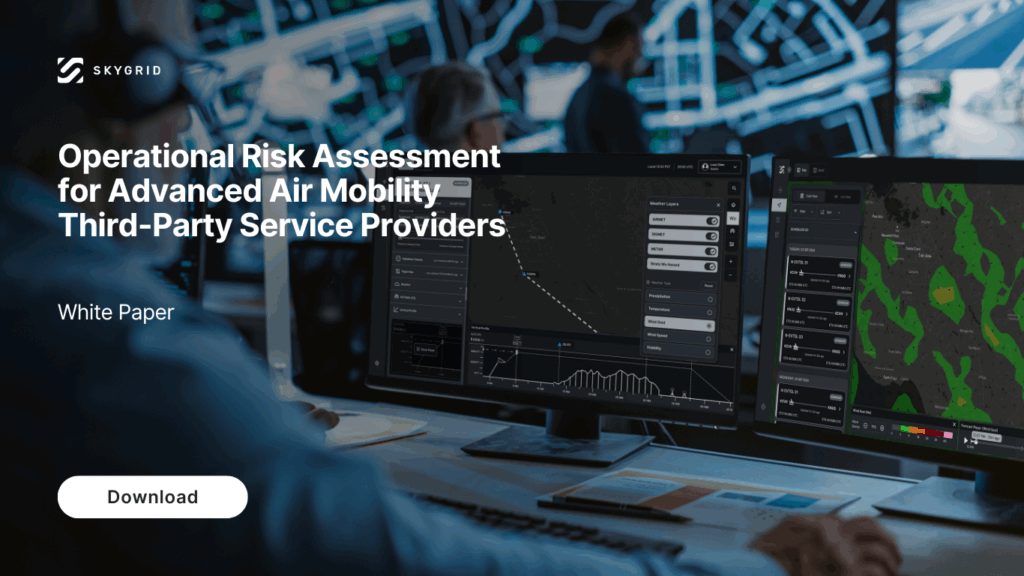As Advanced Air Mobility (AAM) expands, a new class of Third-Party Service Providers (TSPs) will emerge, digitally supporting critical flight operations functions such as real-time airspace awareness, weather monitoring, and traffic management. These digital service providers will play a fundamental role in safely enabling autonomous and highly automated aviation.
To ensure safe, scalable AAM operations, the industry must establish clear safety standards for TSPs. SkyGrid’s latest whitepaper, Operational Risk Assessment for Advanced Air Mobility Third-Party Service Providers, urges industry leaders and regulators to collaborate on defining a robust safety framework for TSPs. A structured Operational Risk Assessment (ORA) can help bridge critical gaps in evaluating the risks associated with these emerging service providers.
The Hidden Safety Gap for TSPs in AAM
Unlike traditional aviation operations, where onboard systems are designed and certified with well-established safety standards, AAM will rely on offboard, decentralized digital services. AAM operations introduce new stakeholders, new levels of complexity, and new risks. From the perspective of the TSP operating in AAM environments, certain areas must be reinforced for safety.
Key Challenges of TSP Safety in AAM:
- Decentralized Operations: TSPs will remotely manage functions across multiple aircraft, introducing new risks that current industry safety standards do not directly and fully address.
- Interconnected Systems: TSPs will interact with multiple stakeholders (aircraft, Air Traffic Control, cloud-based networks), introducing new risks from data integrity failures, service disruptions, or miscommunication.
- Lack of Clear Safety Guidance: Current aerospace safety standards (e.g., SAE ARP4761) focus on aircraft and onboard systems but do not provide a structured methodology for evaluating TSPs in AAM.
Without updated risk assessment methods, the industry risks fragmented accountability, inconsistent safety oversight, and undetected operational hazards.
Operational Risk Assessment: A Solution for AAM TSP Safety
To address these challenges, SkyGrid proposes integrating an ORA as a complementary safety evaluation method for TSPs.
What is an ORA? An Operational Risk Assessment (ORA) is a structured framework designed to evaluate and mitigate risks associated with TSPs in AAM operations. Unlike traditional safety assessments that focus on isolated systems, an ORA examines the broader ecosystem, including operational interactions, data integrity, and risk propagation between TSPs and multiple aircraft.
Why ORA is Needed:
- Evaluates TSP risks beyond current ARP4761 standards
- Strengthens safety case for TSP approval & regulatory compliance
- Ensures TSPs meet safety-of-life requirements for AAM
How ORA Fills the Safety Gap:
- Evaluates TSP risks beyond current ARP4761 standards
- Strengthens safety case for TSP approval & regulatory compliance
- Ensures TSPs meet safety-of-life requirements for AAM
- Identifies & Mitigates System-Wide Risks – Assesses how a single TSP failure could impact multiple aircraft.
- Evaluates Operational Data Integrity – Ensures real-time flight data (such as weather, traffic alerts) is accurate, secure, and reliable.
- Incorporates Elements from Multiple Safety Analysis Methods – Integrates established methodologies like System-Theoretic Process Analysis (STPA), Safety Critical Functional Thread Analysis (SCFTA), and Specific Operational Risk Assessment (SORA).
Combining insights from proven safety assessment methods like STPA, SCFTA, and SORA provide a good starting point for an ORA—a method with the potential to create a more comprehensive and adaptable approach to assessing TSP safety.
Working Together to Prioritize Safety
As AAM expands, operational safety responsibilities become harder to define due to interconnected components across multiple organizations, including TSPs, vehicle operators, and regulators. An ORA can provide structured guidance to help stakeholders navigate these boundaries, ensuring clear accountability and consistent safety standards.
An ORA also helps stakeholders understand the risks associated with TSP systems by examining interactions within the ecosystem and their impact on overall safety. This holistic approach ensures safety considerations are not overlooked, prevents fragmented accountability, and promotes a cohesive and secure approach to operating AAM flights.
Regulatory bodies, industry leaders, and stakeholders must acknowledge the evolving role of TSPs and prioritize their integration into the AAM safety sphere. Collaboratively developing tools to build safer distributed ground- and cloud-based systems will support the advancement of digital and automated operations. This joint effort is crucial for a seamless and secure transition to a future where advanced aerospace infrastructure becomes a safe and integral part of global transportation.
TSPs will be critical to AAM operations, but current aviation safety frameworks don’t fully cover their risks. An Operational Risk Assessment provides a structured, ecosystem-wide approach to evaluating TSP safety. Industry collaboration is essential to establish clear, scalable safety standards for TSPs before AAM reaches widespread adoption.
Learn more in the white paper.

